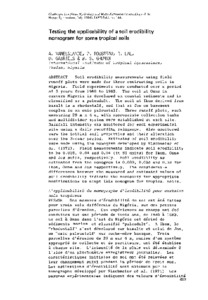| dc.contributor.author | Vanelslande, A. |
| dc.contributor.author | Rousseau, P. |
| dc.contributor.author | Lal, R. |
| dc.contributor.author | Gabriels, D. |
| dc.contributor.author | Ghuman, B.S. |
| dc.date.accessioned | 2019-12-04T11:27:02Z |
| dc.date.available | 2019-12-04T11:27:02Z |
| dc.date.issued | 1984 |
| dc.identifier.citation | Vanelslande, A., Rousseau, P., Lal, R., Gabriels, D. & Ghuman, B.S. (1984). Testing the applicability of a soil erodibility nomogram for some tropical soils, Challenges in African Hydrology and Water Resources: Proceedings of the Harare Symposium, July 1984. IAHS, (p. 463-473). |
| dc.identifier.uri | https://hdl.handle.net/20.500.12478/4820 |
| dc.description.abstract | Soil erodibility measurements using field runoff plots were made for three contrasting soils in Nigeria. Field experiments were conducted over a period of 3 years from 1980 to 1983. The soil at Onne in eastern Nigeria is developed on coastal sediments and is classified as a paleudult. The soil at Ikom derived from basalt is a rhodustalf, and that at Jos on basement complex is an oxic paleustalf. Three runoff plots, each measuring 25 m x 4 m, with appropriate collection tanks and multidivisor system were established at each site. Rainfall intensity was monitored for each experimental site using a daily recording raingauge. Also monitored were the initial soil properties and their alteration over the 3-year period. Estimates of soil erodibility were made using the nomogram developed by Wischmeier et al. (1971). Field measurements indicate soil erodibility to be 0.015, 0.04 and 0.04 (in SI units) for Ikom, Onne and Jos soils, respectively. Soil erodibility as estimated from the nomogram is 0.039, 0.025 and 0.18 for Ikom, Onne and Jos respectively. The considerable differences between the measured and estimated values of soil erodibility indicate the necessity for appropriate modifications to adapt this nomogram for tropical soils. |
| dc.description.abstract | 1984Des mesures d'érodibilité du sol ont été faitespour trois sols différents du Nigeria, sur des petitesparcelles d'érosion. Ces expériences au champs ont étéconduites sur une période de trois ans, de 1980 à 1983.Le sol à Onne dans l'est du Nigeria est dérivé desédiments marins et classifié "paleudult". A Ikom, le"rhodustalf" s'est développé sur basalte et celui de Jos,un "oxic paleustalf" sur roche-mère basique. Troisparcelles d'érosion de 25 m sur 4 m, munies d'un systèmeapproprié de collecte et de partiteurs, ont été établiesà chaque site. L'intensité de la pluie est déterminée àl'aide d'un pluviomètre enregistreur journalier. Lescaractéristiques initiales du sol ont été relevées etleur changement suivi pendant la période de trois ans.Les estimations d'érodibilité sont obtenues par lenomographe développé par Wischmeier et al. (1971) Lesmesures expérimentales indiquent des valeurs d'érodibilité463464 A.Vanelslande et al.de 0.015, 0.04 et 0.04 (unités SI) pour Ikom, Onne and Josrespectivement. Les estimations du nomographs sont 0.039,0.025 et 0.18 pour les sols de Ikom, Onne et Josrespectivement. Les différences considérables entre lesvaleurs mesurées et estimées indiquent la nécessité demodifications appropriées, pour l'adaptation de cenomographe aux sols tropicaux. |
| dc.language.iso | en |
| dc.language.iso | fr |
| dc.subject | Soil |
| dc.subject | Eroded Soil |
| dc.subject | Soil Erosion |
| dc.title | Testing the applicability of soil erodibility nomogram for some tropical soils |
| dc.type | Conference Paper |
| cg.contributor.affiliation | International Institute of Tropical Agriculture |
| cg.coverage.region | Africa |
| cg.coverage.region | West Africa |
| cg.coverage.country | Nigeria |
| cg.iitasubject | Soil Information |
| cg.iitasubject | Soil Health |
| cg.accessibilitystatus | Limited Access |
| local.dspaceid | 101643 |

